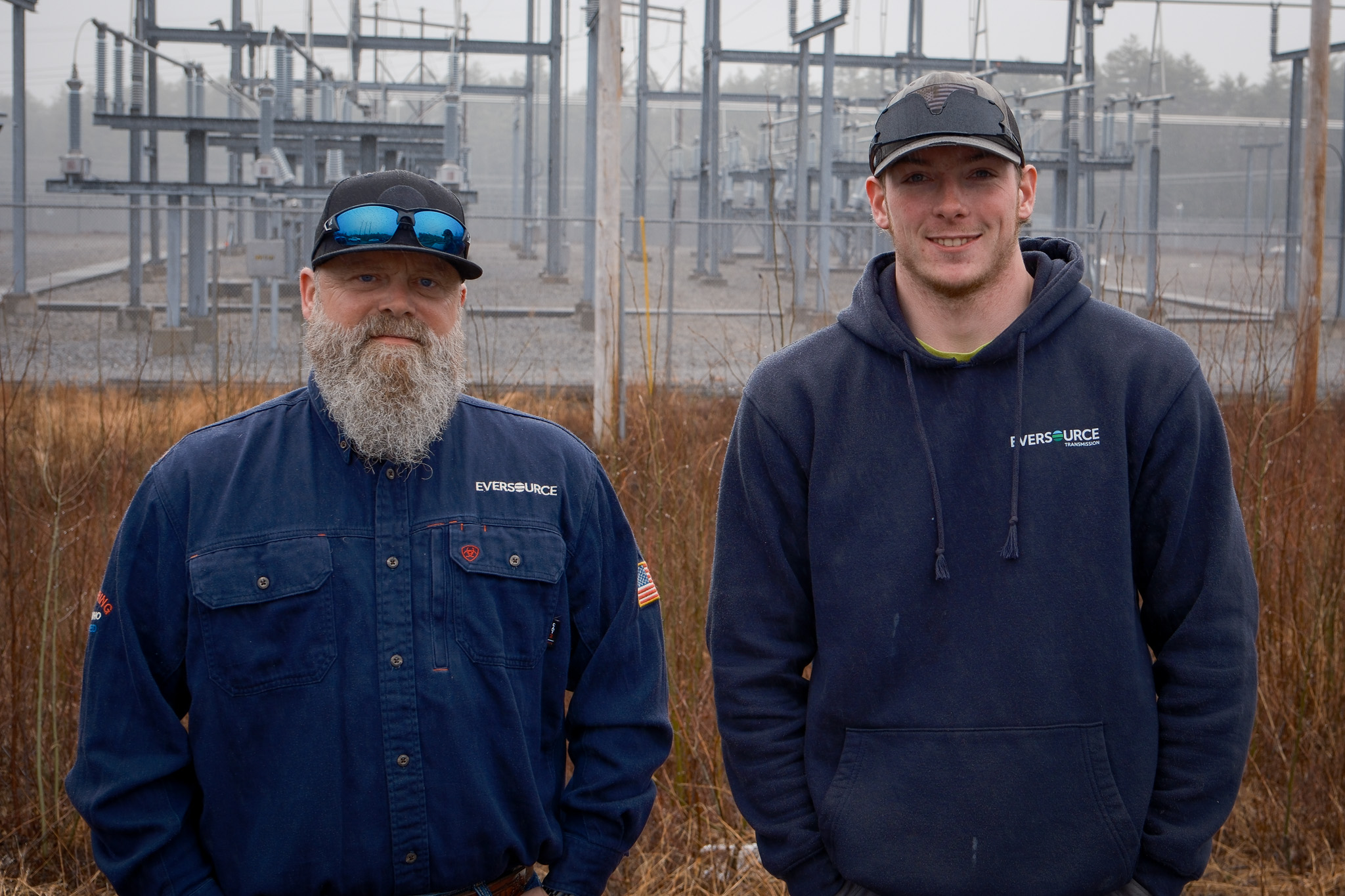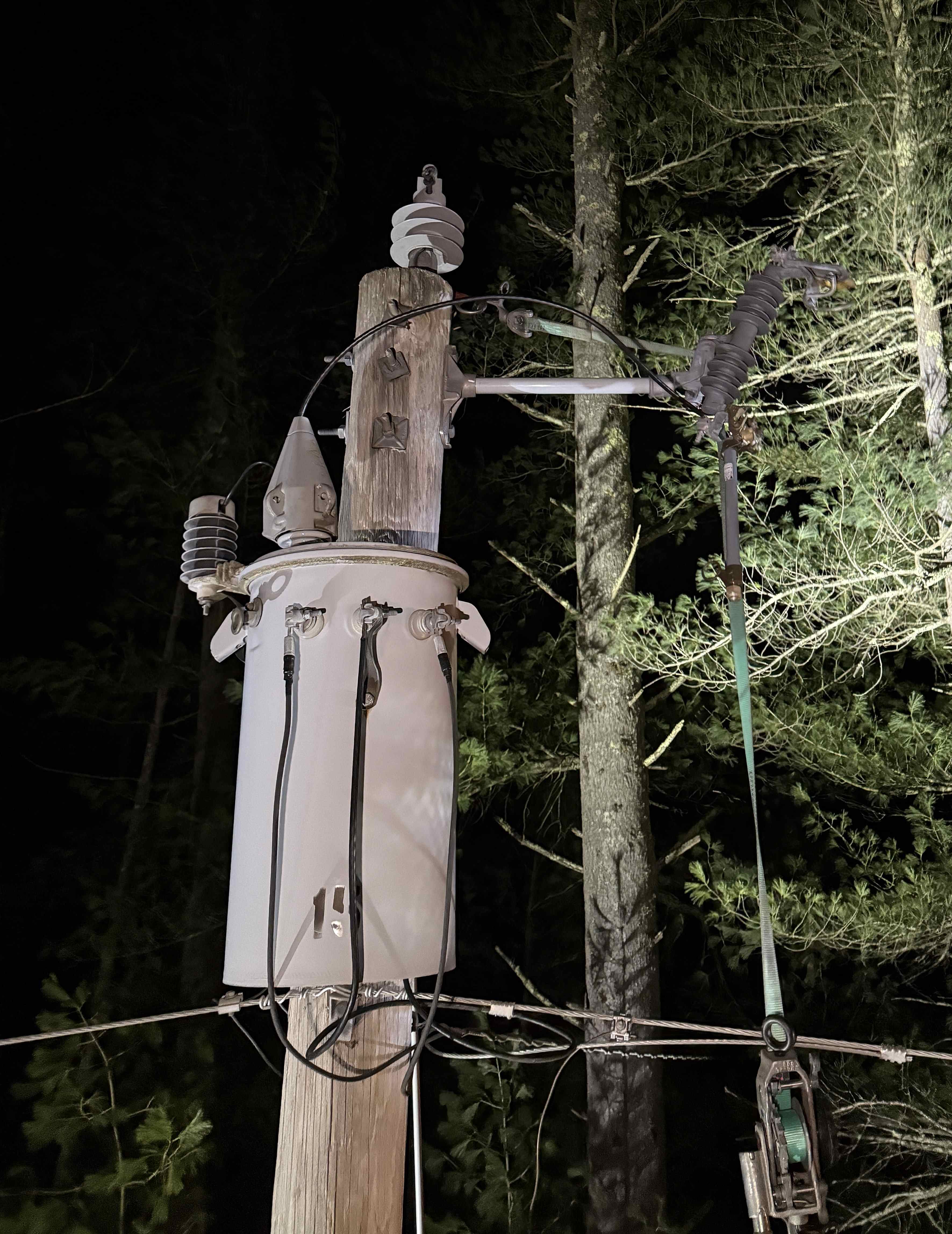Information on this page is for customers in
{{ town-name }}
Power Goes Both Ways

Bzzzz...Working Foreman Jason Stickney (pictured left) and Apprentice Lineworker Ben Boudette (pictured right) were on a standard job in Brookline, New Hampshire, during a recent storm restoration.
They were repairing four spans of a downed power line, when Ben heard a faint sound coming from the top of the last pole, where the primary line had ripped from the transformer. Bzzzzz...
“It sounded like a can or a bad connection or something,” he recalled. Bzzzzz... “But the first thing that sparked in my head was that I also noticed the sound of a generator in the distance, so I thought I should probably pay extra attention.” He went up to investigate the top of the pole, and heard it again. Bzzzzz... "At that point, my gut just told me to test the line."
Sure enough, the load side of the cutout was energized. That, plus the knowledge that a generator was being used, could only mean one thing: a home generator was back-feeding into the customer’s service line that was connected to the pole. It meant that the generator wasn’t installed with a transfer switch, which is a big deal.
The top of the transformer — where they needed to reconnect the primary line — was energized and could have electrocuted anything that brushed up against it. Bzzzzz…
It’s the kind of story you hear about in lineworker safety training, though you might go your whole career without seeing an example in the field. “I’ve been doing this for 25 years,” said Jason. “And this is the first time I’ve ever seen it happen.”
Normally, in a storm situation, they wouldn’t have disconnected the transformer before reconnecting the primary line. “Nine times out of ten, or even higher, generators are installed properly,” said Jason. Thankfully, Ben heard the faint buzzing and put two and two together.
Generators can back-feed power
A generator at home can be a great backup plan if the power goes out, but you must use it safely. No matter the size, generators should always be installed by a licensed electrician and connected to your home’s wiring through a special transfer switch. This ensures electricity produced by the generator doesn’t back-feed into the power lines and harm the line crews repairing the wires.
Using a transfer switch is basically like raising the drawbridge to a castle so that no one inside can leave. Except with a transfer switch, the gate closes automatically when the generator turns on. Again, this needs to be set up by a professional electrician.
“If you have a generator hooked up improperly and it doesn’t disconnect from the electrical grid,” said Ben, “There’s nothing stopping the power from going right back up the lines the same way it came down in the first place.”

Treat it like it’s hot
The power used by a typical residential home is 120/240 volts, which is stepped down from higher voltage power lines using a transformer — the grey, can-shaped device on top of poles. But here’s the thing about transformers: they don’t care which way the power is flowing.
Sending electricity back into it does the same thing, but the exact opposite. Jason explained: “So, there’s low voltage coming out of the house, and it goes back up the line and into the windings of the transformer, and then the higher primary voltage comes out the other side, which in this case, was where the line broke.” The primary voltage is 7,200 volts. Bzzzzz…
It's easy to understand why one of the first messages we post during a storm is: Don’t go near downed power lines; always assume they are live. “It’s the very first thing we’re taught,” said Ben. “If you can’t prove it’s de-energized, treat it like it’s hot — never, ever, assume a line is de-energized. This is why we wear the big rubber gloves; it saves lives.”
Ultimately, you should always assume power lines are live.
All quiet on the line
Once they determined the line was hot, Jason and Ben went to the house and explained the situation to the customer, asking them to turn off their generator." And then after that,” said Ben, “The buzzing was gone. So, I went back up again, tested and verified that it was all de-energized, and then we finished reconnecting the primary line and continued restorations as usual.”
Safety is embedded in our culture at Eversource, and it’s always our team’s priority as we work to serve our customers. “These guys did a great job,” said Director of Field Safety Chris Stock. “Fortunately, this story isn’t common, but it’s exactly the kind of situation our lineworkers train for.” That doesn’t mean you can skip the professional installation when buying a generator for your home.
“Electricity is a part of our everyday lives,” said Chris. “But it’s still dangerous when used improperly, and that can affect everyone in the community.” If you’re not sure the status of your home generator, or need to get a new one installed, we recommend contacting your friendly, certified, neighborhood electrician.
Generator Safety
A generator can be a great backup plan if the power goes out, but it must be used safely.